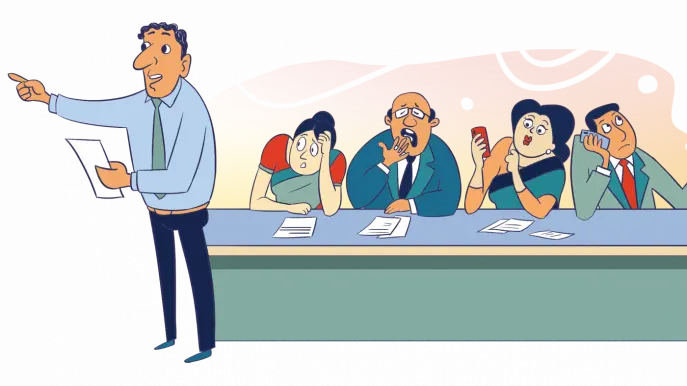Why Your PowerPoint Slides Are Boring (And How to Fix Them)
- Pitch Perfect Design

- Feb 24
- 4 min read
PowerPoint and other presentation tools are powerful ways to communicate ideas, but most slides end up being overcrowded, unengaging, and forgettable. If your audience is zoning out, checking their phones, or simply not retaining your message, your slides might be the problem.

So, why are your presentation slides boring—and more importantly, how do you fix them?
1. Too Much Text
The Problem:
Many presenters overload their slides with text, essentially turning them into a wall of words. If people are busy reading, they aren’t listening to you.
🔴 Example of a Bad Slide:
Long paragraphs of text
Speaker reading directly from the slides
No hierarchy of information
The Fix:
✅ Keep slides concise (aim for 5-7 words per line, 3-5 bullet points per slide).
✅ Use keywords, not full sentences—save the details for your speech.
✅ Break up text-heavy slides into multiple, more digestible slides.
🔹 Real-World Example: Steve Jobs’ presentations were legendary because his slides contained minimal text—just a few key words per slide—allowing him to tell the story.

2. Boring, Overused Templates and Clip Art
The Problem:
Default PowerPoint templates and generic clip art make your presentation look outdated and uninspired.
🔴 Example of a Bad Slide:
Standard PowerPoint theme
Generic stock images that don’t add value
Clashing colors and inconsistent fonts
The Fix:
✅ Use modern, custom slide designs with consistent fonts and color schemes.
✅ Replace clip art with high-quality visuals, icons, or illustrations.
✅ Consider professional design tools like Canva, or presentation agencies like Pitch Perfect Design
🔹 Real-World Example: Airbnb’s pitch deck is widely praised for its clean and professional design—simple, elegant, and visually compelling.
3. Lack of Visual Hierarchy (Everything Looks the Same)
The Problem:
If all your text is the same size and weight, your audience won’t know what’s most important. A lack of visual hierarchy makes slides look cluttered and overwhelming.
🔴 Example of a Bad Slide:
Every bullet point is the same size and color
No differentiation between key points and supporting text
The Fix:
✅ Use larger fonts for headlines, bold important words, and use contrasting colors to highlight key points.
✅ Structure slides so the most important content stands out first.
✅ Add spacing and white space to make slides easier to read.
🔹 Real-World Example: TED Talk slides use strong contrast, clear fonts, and intentional spacing to guide the audience’s attention effectively.
4. Too Many Bullet Points (Slides Shouldn’t Be a Script)
The Problem:
If every slide is just a list of bullet points, your audience will lose interest fast.
🔴 Example of a Bad Slide:
10+ bullet points on one slide
No visuals, just text
The Fix:
✅ Replace some bullet points with images, charts, or infographics.
✅ Use one key message per slide.
✅ Consider progressive disclosure (revealing points one at a time) to keep attention.
🔹 Real-World Example: Elon Musk’s Tesla presentations use minimal bullet points—he focuses on strong visuals and data instead.
5. No Storytelling (Just Facts, No Emotion)
The Problem:
Facts alone don’t engage people—stories do. A presentation without a compelling narrative feels dull and forgettable.
🔴 Example of a Bad Slide:
Data dumped onto a slide with no context
No emotional connection with the audience
The Fix:
✅ Start with a problem-solution narrative (e.g., introduce a challenge, then show how your idea/product solves it).
✅ Use real-life examples, case studies, or personal anecdotes.
✅ End with a clear call to action—what do you want your audience to do?
🔹 Real-World Example: Nike’s marketing presentations don’t just showcase products; they tell inspiring stories about athletes overcoming challenges.
6. Overuse of Complex Charts & Data Dumps
The Problem:
If your audience can’t instantly interpret a graph, it’s useless. Too many numbers or complex visuals overwhelm people.
🔴 Example of a Bad Slide:
A cluttered Excel table copied onto a slide
A graph with multiple colors, labels, and unreadable text
The Fix:
✅ Simplify data: Show only the most important numbers.
✅ Use easy-to-read bar charts or infographics instead of dense tables.
✅ Highlight key insights using arrows, bold text, or callouts.
🔹 Real-World Example: Apple’s keynotes use simple, elegant charts that make numbers easy to understand at a glance.
7. No Engagement (Your Slides Should Support, Not Replace, You as the Speaker)
The Problem:
Your slides should enhance your talk, not replace it. If your audience can read everything without listening to you, your slides are doing all the work.
🔴 Example of a Bad Slide:
A slide with complete sentences, eliminating the need for a presenter
No interaction with the audience
The Fix:
✅ Make slides visual prompts, not full scripts.
✅ Engage your audience with questions, polls, or storytelling.
✅ Use a conversational tone and avoid reading directly from slides.
🔹 Real-World Example: Simon Sinek’s TED Talk (“Start With Why”) is famous for its minimal slides and engaging delivery. His visuals supported his talk without overshadowing his words.
Conclusion: Make Your Slides Work for You, Not Against You
A great presentation is simple, engaging, and visually appealing. Here’s a quick checklist to make sure your slides aren’t boring:
✅ Less text, more visuals
✅ Consistent, professional design
✅ Clear visual hierarchy
✅ Engaging storytelling
✅ Simplified data and charts
✅ Strong speaker-audience interaction
By applying these principles, you can transform dull PowerPoint slides into powerful, engaging presentations that capture attention and drive action. 🚀
Would you like a free consultation to improve your pitch deck or business presentation? Contact us today! 💡


